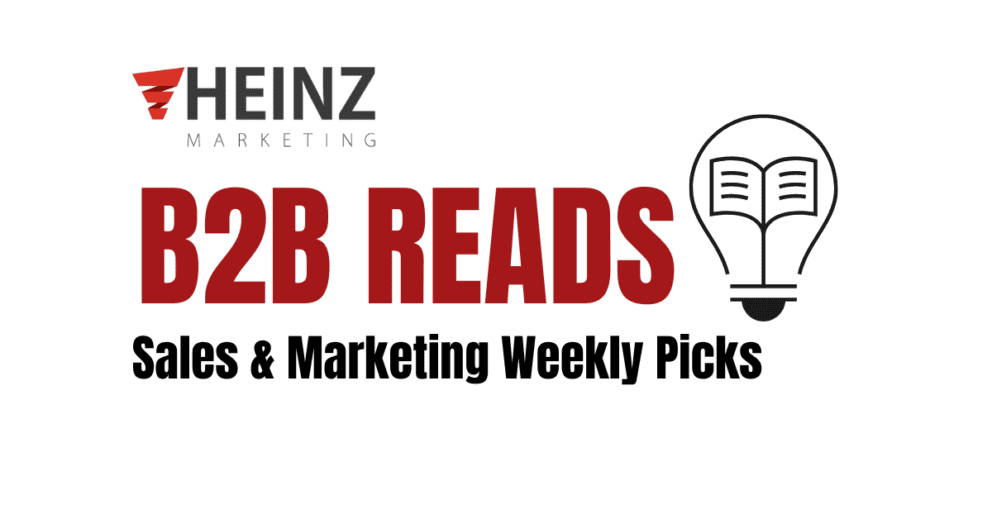B2B Reads: Quality Engagement, Personalization Strategy, & Audience Captivation

In addition to our Sunday App of the Week feature, we also summarize some of our favorite B2B sales & marketing posts from around the web each week. We’ll miss a ton of great stuff, so if you found something you think is worth sharing please add it to the comments below.
4 Tips for Reengaging with Audiences Post-Pandemic
As the pandemic is beginning to slow and life starts to evolve again, businesses must focus on how to brand themselves outside of this global disruption. Ensuring the remembrance of a company’s core stakeholders, reframing their story and telling it consistently, prioritizing internal communications, and remaining optimistic will all help businesses reengage with their audiences as the pandemic ending is near. Thank you, Edward Wyatt, for sharing your insights on reengagement.
Triad Tempo: Create Quality Engagement
The Triad Tempo is a strategy utilized to develop success in businesses through creating quality engagement. This is done by first, anticipating well-qualified customers who have many questions, value their time, and are selective with who they trust. The Triad Tempo will provide these individuals with meaningful content that is purposed for them to ask questions after the company has identified the three main platforms this communication will occur on. The content involved will include high-value material, source information, and provide commentary to prospective customers with the anticipated outcome of increased quota attainment. Thank you, Colleen Francis, for breaking down this helpful strategy for quality engagement.
Should You Trust Your Gut?
We constantly second guess ourselves as human beings, but it’s important that we take advantage of our natural instincts and listen to our intuition. This is part of our decision making process, while it may not always be right, it can assist you in important life choices. Thank you, Phil McKinney, for reminding us to trust our intuition.
Dealing With A Hostile Audience
While some audiences may be excited and open to hearing your speech, others may have a more negative reaction. To combat this hostile progression, it’s important to deliver your presentation in a way that will prevent your audience from tuning you out through being clear, audience adaptation, maintaining control, staying neutral, and being open. Thank you, DrJim, for informing us of how to navigate these difficulties.
Are You Leading a Team or a Group?
One of the biggest misconceptions is the difference between a group and a team – the key differentiating factor is that a group has no interdependency whereas a team works together to achieve an agreed upon goal. The way that they work towards achieving the goal is similar along with being rewarded interdependently. Leading a team can be more beneficial and rewarding as you’re functioning as one unit and working together towards a common goal. Thank you, Susan Fowler, for identifying the differentiation factors of a group versus team for maximum productivity.
7 Questions to Answer When Planning Your Personalization Strategy
Personalization is an incredibly dominant trait to possess in the current market as it’s scaled between $1-3 trillion in value. Capitalizing on this opportunity requires strategy and this includes determining goals, success measurement, team involvement, technology, target audience, data segmentation, and content creation. Thank you, Mia McPherson, for helping us understand the importance of developing a personalization strategy and how to do so.
How to Speak with Confidence & Captivate your Audience
One of the most important characteristics that makes a great speaker is their confidence. While some are born with it naturally, others have the ability to acquire it. Some tips to help grow confidence to captivate your audience include practice, trust in yourself and audience, good health, growth mindset, visuals, momentum, avoiding filler words, tone variation, and dressing for success. Read further for elaboration on each of these tips. Thank you, Brian Tracy, for highlighting the importance of confidence in audience captivation.
What Makes a Company “Future Ready”?
Within the past couple of years, the pandemic has helped test many businesses under copious amounts of stress to determine who is ready for upcoming changes in the future. Essentially, becoming future ready focuses on scaling up capabilities relevant to future competition. Read further for more information and insight on who is considered to be future ready. Thank you, Howard Yu, Jialu Shan, Angelo Boutalikakis, Lawrence Tempel, and Zuriati Balian, for helping us identify what defines success post-pandemic.
Focus on This Often Overlooked Factor to Boost Sales and Profitability
While company culture is often associated internally within a company, it can be leveraged externally as well to enhance a business’s brand in the marketplace through the business community and to the general public. Utilizing a company’s culture to increase sales and profit is a unique opportunity for leaders to differentiate themselves from their competitors based on their morale. Thank you, Steve Arizpe, for noting this simple, yet unique business opportunity.
How Leaders Can Promote Happiness In Teams
People want to work for companies who care about them and their wellbeing, but it’s also notable that productivity is often correlated to employee happiness. Making positivity a habit, embracing humor, building cognitive trust, being kind, valuing all roles, surprising, and recognizing are all examples of how leaders can promote happiness within the workplace. Thank you, Sally Percy, for sharing these happiness tips.

